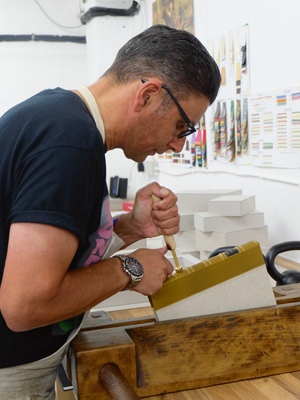Bindery manager, Chris Narayan, is ‘a medieval bookbinder of international renown’
Unlike the adage of two steps forward one step back, Rapidity’s renaissance bindery is a case of embracing the past to leap forward.
Bookbinding predates printing, and the techniques and materials used for hand binding today would have been familiar to Gutenberg. So, Digital Printer was fascinated to learn that digital print firm Rapidity had employed a master bookbinder and had bought a press that was more than a hundred years old. It sounded incongruous that a firm better known for being on the cutting edge – whose last move had been into wide format with a flatbed printer and cutting table – was eschewing zero-touch fully-automated kit for something very hands on indeed.
‘It is the best of both worlds, combining the traditional with the latest technology,’ says managing director Paul Manning of the new venture.

The 126-year-old refurbished Imperial press used for foiling
Rapidity, which is based on the fringes of the City in Clerkenwell, London, has more recent origins. It celebrated its 30th birthday this year, having been founded in 1986 as Printflow by Mr Manning’s father Les. That was the year of the Big Bang, the deregulation of the City of London’s financial markets, when one indispensable status symbol and business tool was the not-so-little-black-book – the Filofax – and for yuppies, a classy leather-bound number was just the thing to be seen with. A lot has changed in the past 30 years, never mind the last 500, but it is clear that the market for hand crafted books, made from the finest materials has not just survived, it is thriving, driven by an increased recognition of the physical as our lives become ever more digital. That Filofax usurped for the contacts and calendar on our smartphones being one example.
Young at heart
While Rapidity has just celebrated its 30th, it is in the unusual position for a print firm of having a large number of staff who have yet to reach that milestone.
Mr Manning claims that: ‘We have a much younger average age than the rest of the print industry, a lot are in their 20s’. Many of the rest started out young at the firm and stayed with ‘a lot having come up through the ranks, to become some of our best staff’.
So where does the bindery fit? Mr Manning says: ‘the business has a strategy – an overall direction. Our central London location is 50% of that and, because of it, we do a lot of same day work, but that cannot be everything. Increasingly the work we produce is complex – there needs to be a dialogue between the client and us to get it right; it isn’t commodity work. We’ve worked out that there is a sweet spot for us, which is digital, wide format and finishing.’
‘The bindery serves a lot of the markets that we already operate in, especially the London market. It is suitable for promoting property and high value products such as boats and cars; it fits well with existing clients in sectors such as agencies, architecture, design and finance.’
Rapidity’s ‘new’ bindery offers thread sewing, cloth and leather binding and foiling. In addition to books, it also produces boxes and presentation cases using the same traditional techniques and materials. In contrast to the latest highly automated equipment from the likes of Duplo and IFS on the other side of the factory, the tools in the bindery are often old; the Imperial press used for hot foiling was made in 1890. Alongside is an array of book presses/nipping presses, used to ensure the products produced are flat and true.
Hands on
At the heart of the new venture is bindery manager Chris Narayan, whom Mr Manning describes as ‘a real craftsman, properly qualified to lecturer level and a medieval bookbinder of international renown’.

Chris Narayan hand foiling a book’s spine
Mr Narayan trained in the 80s at LCP. Subsequently he worked in a number of places, including Aberdeen University and Felton Bookbinding in Georgetown, Canada. While there, he spent five years as part of a team of five bookbinders. One project was an edition of 950 hand-crafted books called its Keough’s Antarctica. The full-leather volume featuring 345 images and weighing 27 pounds has been described as ‘one of the most beautiful handmade books ever’.
Mr Narayan has a trove of hand tools, each optimised for a particular task, and almost part of him. Watching him in action it is clear this is a craftsman who has honed his skills over decades until they are instinctual, making it look effortless. Some of the processes he only gets one shot at, often late in the production process, so they have to be just right – like Goldilocks’ porridge. If the tool is too hot, or too cold or he presses too hard, or not hard enough the result will be irretrievable.
Getting into the swing
‘It is like golf, you have to practise regularly to keep your hand in,’ said Mr Narayan.
Often the projects produced combine his skills with modern materials and aesthetics, which can present challenges. As he explains ‘you can’t foil everything and there is a lot of interplay, learning what can and can’t work’. Which goes back to Mr Manning’s point about working closely with the client.
In addition to making new books Mr Narayan also restores them, with the oldest work he has been involved in dated from the 15th Century. He is currently restoring a number of books for a private members club, one of which is so valuable it’s not allowed out of the club’s safe unsupervised.
Mr Manning concludes: ‘we expect the bindery to grow and I can see Chris managing a team, including taking on and training up apprentices.’





